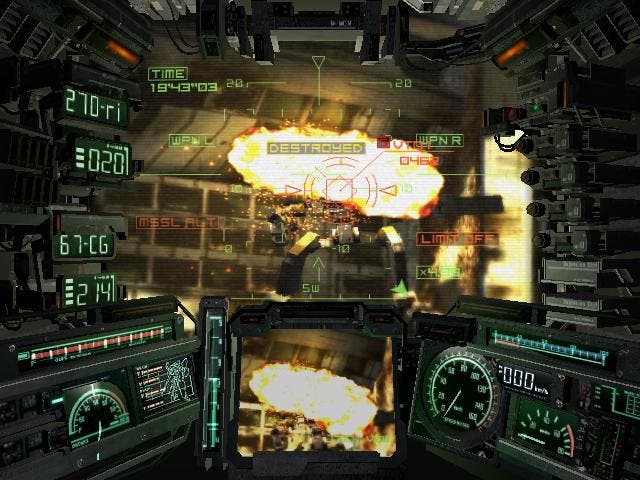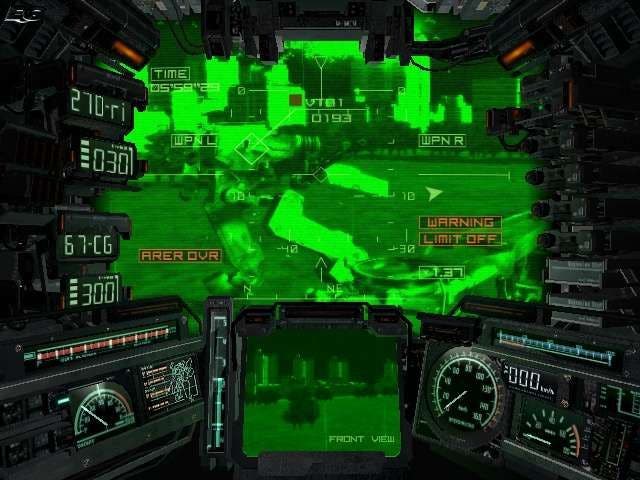Steel Battalion
What happens when you cross a JCB with Optimus Prime?
It's finally time to answer that most debateable of questions: would we pay £129.99 for Steel Battalion? However, it seems that the question itself is rather irrelevant now, with the game available in such miniscule quantities that anybody still perched on the fence without a pre-order to their name is unlikely to end up with a copy, online auctions notwithstanding. So, ultimately, the fact that we wouldn't pay £129.99 to play it seems quite moot.

Galvanised by complexity
You're all no doubt aware of why the game costs so much, but let's recap just in case. Steel Battalion is a 'mech simulator' rather than an action game, and it comes bundled with a three-part, 40-button controller, three times the size of Xbox, complete with gear sticks, joysticks, foot pedals and pointless flip switches. And Capcom's idea of a mech isn't the super-sleek, humanlike anime realisation, but more of a genuine piece of heavy machinery - with quirky handling, acceleration that would shame a Sinclair C5, and the lumbering posture of a constipated knight in armour.
As a result, it's a game with a worryingly steep learning curve. Whereas other mech games are happy to shower you with praise for being the only man in the universe capable of hitting the A and B buttons occasionally, you generally are elite if you can overcome the odds in Steel Battalion.
At the heart of the game is a menacing campaign mode with a boring military story, which starts off by thrusting you into the cockpit of the Pacific Rim's prized Vertical Tank and screaming RTFM - no exaggeration. Fortunately, the manual in question is mercifully brief for a game like this and acts as a handy reference guide throughout. You'll quickly get used to the VT boot-up sequence; hitting buttons, reaching for flip switches and cranking gears. After a while it's second nature.
But as you start off it's obvious that this is no mere arcade shooter with a fancy peripheral. You'll need to keep an eye on your gears, because acceleration is slow and cumbersome, whilst watching your joysticks, watching the radar, maintaining ammo levels, washing your screen occasionally and keeping in touch with wingmen. Your joysticks have many uses - the left stick controls steering primarily, with a little thumb stick on top handling the viewfinder (click it in, "R3-style", to centre), and the right stick controls the right-side arm of the mech, which is equipped with rockets and so on. There's a trigger on it and lock on/fire buttons under your thumb. On the whole, controlling a VT sounds complex because it is.

TV versus VT
However, the actual game (i.e. the on-screen bit) is slightly less inspiring than the grown-up kiddy controller. A lot of the screen is taken over by mostly static details, like ammo counters, radars, readouts and data overlays. You can toggle certain elements, like the radar screen, and later on in the game you're rewarded with large-screen mechs, but even then you're still going to be squinting at what goes on outside the cockpit on anything less than a 28" TV. In fact, it wasn't until we saw the game running on Kristan's 36" widescreen TV [my pride and joy - Ed] that we realised the radar shows flying shells. The relatively short distance from couch to 25" TV in our lounge is enough to obscure the pixel-sized projectiles entirely.
The limitations of your VT, too, contribute to the difficulty. To begin with, your objectives are generally 'seek and destroy', clearing the way for reinforcements, and latterly you'll be working under tremendous pressure in confined spaces in the face of insurmountable odds. As such, the core of the gameplay is spread between marshalling your resources effectively (shooting at clearly visible and threatening targets only, getting clear of buildings before firing, saving your limited-ammo, mech-busting weapons for enemy VTs, etc) and pushing your own VT to its fullest without overdoing it. Each VT will tip over like a Robin Reliant in a gale if you turn sharply above a particular speed threshold, and if you hurl shells around the battlefield like George Bush on a Friday night then you'll overheat and risk temporary shutdown - and coming to a dead stop in the midst of a fire fight is not advisable.
Engaging the enemy quickly becomes a case of keeping up a good speed, relying on the lock-on for a sure-fire hit and making liberal use of the dash pedal. The dash pedal is where you'd expect the clutch to be on the heavy, foot-facing aspect of the peripheral. Depending on the gear you're in or the angle of your steering stick, hitting this will give the mech a great burst of speed in a certain direction, useful for evasive manoeuvres when confronted by homing missiles.

Hard to the core
Given the price tag, the learning curve, and the fact that failing to hit the eject button when your VT goes critical will wipe your save games, it's fairly obvious that Steel Battalion is aimed at the super hardcore, so it seems a little odd that more effort hasn't gone into the AI and visuals. The control scheme and mechanics of warfare were clearly the focus, but the pop-up, for example, is atrocious. As you chase a red blip in one of the early levels, a city literally pops out of the mist - it's an effect comparable to Daytona USA on the Saturn, something we hoped we'd never have to say - and although Capcom has made clever use of visual effects, underscoring the simulation aspect with a black and white displays for some VTs, and varying the time of missions to highlight the effect of different light conditions, the overall aesthetic would look more at home on a PS2 than an Xbox at times.
What's worse is that for all the pop-up and grainy, greyscale visuals (however deliberate), the architecture is often no more exciting than that of Panzer Front on the PSX. Buildings are too chunky, enemy units are often just painted bricks, and soldiers on the ground look like toy soldiers. However clever it is to have mechs which move like mechanical diggers rather than Olympic gymnasts, and a massive HUD with a simulation feel, nothing makes up for this sort of detail deficit, particularly given the pop-up and occasional slowdown evident elsewhere. The best thing about the visuals is the constant barrage of explosions, and the way your cockpit goes haywire when you're on the verge of death. Apart from that, we could take them or leave them.
And we're not going to leave out the AI, either - if you can call it that. Although your enemies can handle a rocket launcher with relative skill, your wingmen are so hilariously inept that as they bump into one another for the fiftieth time, get caught on the scenery and generally walk around in circles, you'll wonder just why they're there at all.
Fortunately, the audio side of things hits home with all the force of a rocket propelled grenade in a napalm depository, with some of the most expert use of Dolby Digital 5.1 we've encountered. You really can tell the difference between each kind of incoming and outgoing threat, quickly pinpointing that 100mm cannon shell flying in from the rear, and realising that a bit of dash pedal evasion might be in order. It's just a shame that this precision is limited to the audio.
Shutdown
On the whole, Steel Battalion just doesn't feel like it's worth £129.99. It's a month on and we're not as thrilled by the mostly plastic controller any more. It's big, it flashes and it has that intangible coolness to it, but it'll quickly gather dust and it really does monopolise your living room. And although the game itself is cleverly built in places with nice touches (like forcing you to spend credits wisely, trading off mech features against the ability to ship in supplies mid-mission; and the way the game punishes you for resetting before it can save by stripping you of your mech), you can't escape the technical limitations, the little niggles, the frustration of having to start over every time your flick-and-tap skills desert you, and having to perform that boot-up sequence every single time, and the stupidity of Daytona-level pop-up in an Xbox-exclusive game.
Steel Battalion started off as a fantastic idea - a sort of grown-up Fisher Price spinning mobile to sate the child inside us all - but with a prohibitive price tag and a less than stellar game to back it up, we'd be tempted to wait for a sequel and maybe think about buying it then.

